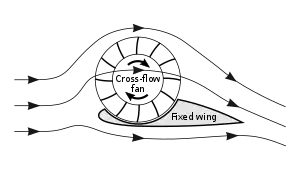
The FanWing is an aircraft configuration in which a horizontal-axis cross-flow fan is used in close conjunction with a fixed wing. The fan forces airflow over the fixed surface to provide both lift and forward thrust.
The concept was initially developed around 1997 by designer Patrick Peebles and is under development by his company FanWing Ltd. As of December 2018, only experimental drones have been flown.
Principles of operation
A cross-flow fan comprises blades radiating from a central axis and aligned with the axis, similar to those of a cylinder mower. It is contained in a duct which is shaped so that when the fan spins, it induces a directional airflow. In the FanWing, the fan is set above the leading section of a fixed wing and extends the full span of the wing. The wing upper surface is shaped around the fan to form a half-duct. The wing chord extends approximately as far again back from the fan, with the rear section shaped as a wedge-like fairing that extends to the trailing edge.
When the fan spins with the upper edge moving backwards and the lower edge forwards, the fixed half-duct is shaped to create a net backward flow of air, resulting in forward thrust. This backward flow over the upper surfaces also creates a net circulation of air around the rotor-wing combination, resulting in vertical lift.
Addition of an outboard tail recovers energy from the wing tip vortices to significantly increase overall efficiency. This in turn allows an even lower minimum forward speed.[1]
Advantages
In addition to providing forward thrust in its own right, the radial fan increases the velocity of the airflow over the wing's upper surface independently of the forward motion of the aircraft, thereby creating useful lift at forward speeds lower than the stalling speed for a conventional wing.[2][3][4]
Limitations
Besides the added weight and complexity of the fan system, it has some limitations compared with a conventional fixed wing:
- The fan speed directly affects pitch. This means that, paradoxically, increasing the engine power can decelerate the aircraft.
- Glide ratio in case of power failure is low (about 1:3) but if the rotors are allowed to auto-rotate, the aircraft can still glide.
- The rotating fan can cause gyroscopic effects which can affect manoeuvrability.[5]
History
Although the cross-flow fan has been known since the late nineteenth century, its use as a rotary aircraft wing was not studied until 1997 when Patrick Peebles, an American based in the UK, conceived of it as a STOL device and subsequently formed the FanWing Co. Wind tunnel tests and powered model flights were supported by UK government funding, winning SMART grant awards in 2002 and 2003.[6] Work began on a prototype drone, ostensibly aimed at the STOL urban surveillance market.[7][8] The benefits of adding a tail were discovered during continued development.[1] By 2014, support for wind tunnel tests of a 1.5 meter wing section was being provided through EU sources including €783,000 through the German Aerospace Center.[9]
As of December 2018, only unmanned development prototypes have flown.
See also
References & notes
- 1 2 Could FanWing go from LSA to heavy lifter?, Robert Coppinger, Aircraft Owners and Pilots Association, November 22, 2011. Accessed June 2012
- ↑ "It looks like a lawnmower, was designed in a kitchen - but it could revolutionise aviation" Archived 2007-10-01 at the Wayback Machine The Independent, 11 November 2002
- ↑ "2004 Year In Ideas: The FanWing" The New York Times Magazine, 12 December 2004
- ↑ "More-powerful Fanwing set to fly" Flight International Magazine, November 2004
- ↑ Seifert, Jost: "A review of the Magnus effect in Aeronautics", Progress in Aerospace Sciences, Volume 55, November 2012, Pages 17-45. (paywalled)
- ↑ "Innovate UK is an Executive non-departmental public body, sponsored by the Department for Business, Innovation & Skills". Innovate UK - the UK's innovation agency. GOV. UK. Archived from the original on 3 May 2016. Retrieved 3 May 2016.
- ↑ FanWing UAV gets airborne after ground roll of only 1m Archived 2007-09-30 at the Wayback Machine Rob Coppinger, Flight International 01/05/07, Accessed August 2007.
- ↑ FANWING - The Fixed-Wing Contender in the Rotorcraft Segment, Archived 2011-02-06 at the Wayback Machine Frost and Sullivan, 10 January 2011
- ↑ Warwick, Graham. "Intermodal-container Air Cargo Concepts Attract Interest (Cargo Cult)" Aviation Week & Space Technology page 15, 25 August 2014. Accessed: 26 August 2014.
External links
- FanWing Ltd company website
- Image of research model with early tail configuration, FlightGlobal (Archived copy).